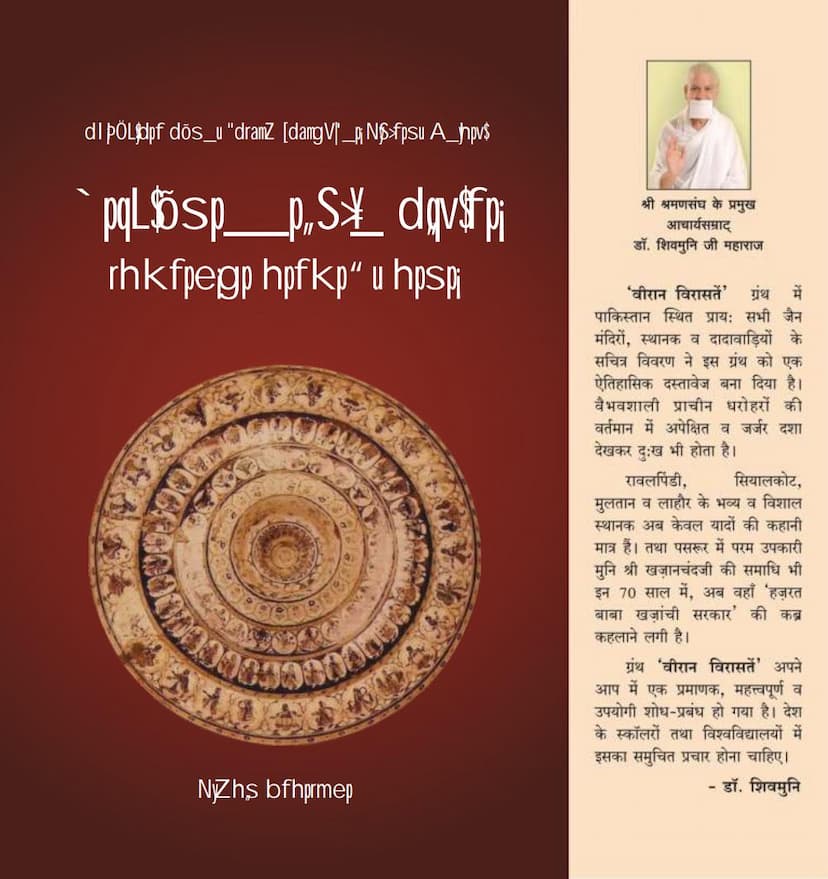Pakistanma Jain Mandiro
Added to library: September 2, 2025

Summary
Here's a comprehensive summary of the Jain text "Pakistanma Jain Mandiro" by Mahendrakumar Mast, based on the provided pages:
Book Title: Pakistanma Jain Mandiro (Jain Temples in Pakistan) Author: Mahendrakumar Mast Original Urdu Work: "Ujde Daran De Darshan" by Eqbal Qaisar Gujarati Translation: Gunvant Barvalia Publisher: Arham Spiritual Centre & Institute of Jainology, Mumbai & Ahmedabad Catalog Link: https://jainqq.org/explore/034398/1
Overall Theme: The book is a historical and travelogue documenting the presence, grandeur, and subsequent decline of Jain temples and sites in Pakistan. It highlights the rich Jain heritage that once flourished in the region, now largely in ruins or repurposed. The work emphasizes the importance of preserving this "forgotten heritage" for future generations and serves as a testament to the historical and cultural connections between India and Pakistan.
Key Points and Content:
- Historical Significance: The book meticulously details numerous Jain temples, sthanaks (monasteries/gathering places), and dadavadis (shrines dedicated to ancestral acharyas) across various cities and regions of Pakistan, including Lahore, Sialkot, Multan, Rawalpindi, Gujranwala, Taxila, Sialkot, Narowal, Pasrur, Kasur, Moro, and Sindh province.
- "Virano Virasto" (Desolate Heritage): The title itself, along with quotes from prominent Jain Acharyas like Dr. Shivmuni Ji Maharaj, reflects the sorrow and pain felt at the sight of the dilapidated and neglected condition of these once-magnificent structures. The text laments the loss of this glorious past.
- Eqbal Qaisar's Original Work: The book's foundation is Eqbal Qaisar's Urdu work, "Ujde Daran De Darshan" (Glimpses of Desolate Places). Mahendrakumar Mast has enriched and expanded upon this by adding his own research, photographs, and detailed descriptions.
- Tragic Transformation: The text vividly describes the impact of historical events, particularly the partition of India in 1947 and later communal tensions (like the Babri Masjid demolition in 1992), on these religious sites. Many temples were destroyed, vandalized, or converted into government offices, schools, or private residences. The author expresses deep sorrow witnessing the destruction and the loss of this heritage.
- Artistic and Architectural Value: Mahendrakumar Mast provides detailed descriptions of the architectural styles, intricate carvings, paintings, idols (though many are now missing or damaged), and the overall artistic grandeur of these ancient Jain structures. The book emphasizes that some of these structures rival or even surpass the artistic achievements seen in famous Indian sites like Ajanta and Ellora.
- In-depth Research and Travelogue: The author's personal journeys through Pakistan are documented, detailing his quest to find these hidden and forgotten temples. He recounts interactions with locals, gathering historical information, and the challenges faced in accessing and documenting these sites. The narrative is presented in a captivating, almost cinematic style.
- The Role of Jain Acharyas and Scholars: The book highlights the significant contributions of various Jain Acharyas and scholars who established and propagated Jainism in this region. It mentions figures like Kalikacharya, Acharya Jinaprabhasuri, Acharya Manadevsuri, Acharya Jinkushalsuri, Acharya Vijayvallabhsurishwarji, Acharya Atmaramji, and Muni Khajanchandji, whose spiritual and scholarly activities left an indelible mark.
- The Impact of Partition: The partition significantly impacted the Jain community in Pakistan. Many families migrated to India, taking with them whatever precious idols and artifacts they could. The book touches upon the poignant stories of these migrations and the subsequent state of the abandoned religious sites.
- The Author's Motivation: Eqbal Qaisar's motivation for writing the original book stemmed from witnessing the destruction of historical sites, particularly in the aftermath of the Babri Masjid demolition. He saw his book as a way to preserve the memory of these Jain heritage sites, as a form of "revenge" for the destruction of religious places on both sides of the border.
- Gujarati Translation's Importance: The Gujarati translation by Gunvant Barvalia is presented as a valuable contribution, making this significant historical research accessible to the Gujarati-speaking community and broadening its reach. It aims to reconnect the community with their shared, albeit now divided, heritage.
- Inclusion of Specific Details: The book includes detailed accounts of specific temples, their locations, the historical periods they belong to, and the stories associated with them. It also mentions the fate of many idols and artifacts, with some being moved to India or preserved in museums.
- A Call for Preservation: The underlying message throughout the book is a strong plea for the preservation of this historical legacy. It highlights the need to protect these sites from further decay and neglect, recognizing them as a vital part of shared human heritage.
- Acknowledgments and Support: The publication acknowledges the support received from various individuals and organizations, including spiritual leaders, scholars, and patrons, indicating a collaborative effort to bring this work to fruition.
In essence, "Pakistanma Jain Mandiro" is more than just a catalog of temples; it's a poignant exploration of a lost era, a narrative of faith and resilience, and a wake-up call to remember and protect the historical and spiritual footprints of Jainism that still exist, however fragmented, in Pakistan.